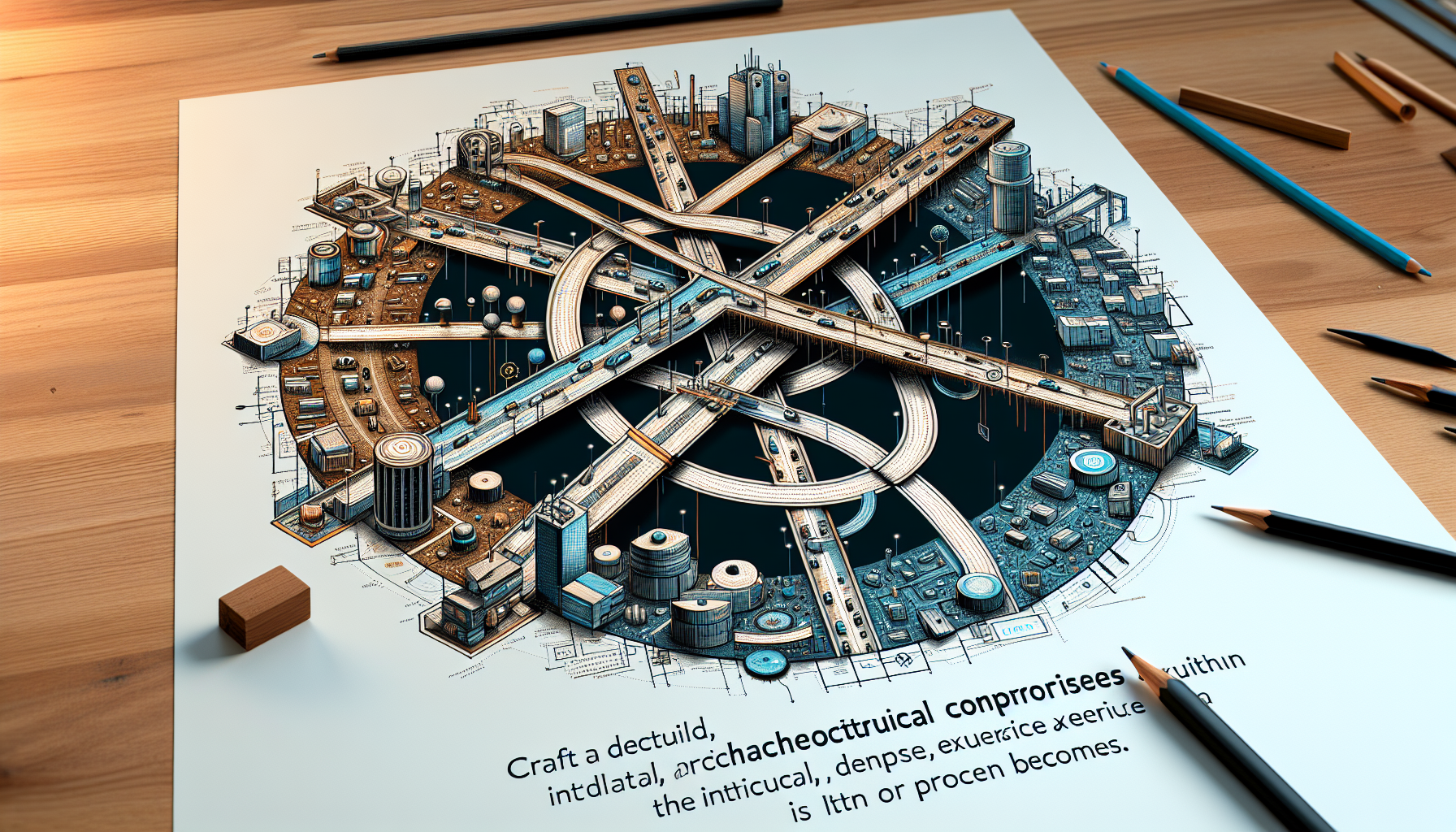“Architectural Trade-offs and Implications: Advanced Insights” offers a comprehensive and practical approach to understanding the complexities of architectural trade-offs in the field of IT solutions. With a focus on the AWS Certified Solutions Architect – Professional exam, this article delves deeply into each topic, providing real-world applications and ensuring a comprehensive understanding of advanced architectural concepts. By structuring lessons around real-world scenarios and case studies, learners are challenged to apply problem-solving skills and design solutions using AWS services. With engaging content and interactive resources such as videos, quizzes, and practical assignments, this article aims to prepare learners for the certification exam by aligning the lessons with the exam blueprint and covering key topics like high availability, security, scalability, cost optimization, networking, and advanced AWS services.
Architectural Trade-offs and Implications: Advanced Insights

1. Introduction to Architectural Trade-offs
Architectural trade-offs refer to the process of making decisions and choices between different design options in the construction of a software or system architecture. These trade-offs involve considering the advantages and disadvantages of each option, as well as their potential impact on various aspects of the system, such as performance, scalability, security, cost, and maintainability.
In the context of software architecture, trade-offs are inevitable due to the complex nature of systems and the competing priorities and constraints that architects face. By understanding these trade-offs and their implications, architects can make informed decisions that lead to the creation of robust and optimized systems.
2. Understanding the Importance of Architectural Trade-offs
Architectural trade-offs play a crucial role in the success of any software or system architecture. They allow architects to balance conflicting requirements and constraints and make decisions that maximize the benefits and minimize the risks associated with various design options.
By carefully considering trade-offs, architects can ensure that the chosen architectural design meets the needs of the stakeholders, aligns with the business goals, and satisfies the technical requirements. Failure to understand and manage trade-offs can result in suboptimal architectures that are inefficient, insecure, unreliable, or difficult to maintain.

3. Common Architectural Trade-offs in the Industry
There are several common architectural trade-offs that architects encounter in the industry. These trade-offs involve balancing two competing factors, and the choices made can have significant implications on the overall system architecture.
3.1 Simplicity vs. Complexity
One of the fundamental trade-offs in software architecture is simplicity versus complexity. While a simple architecture is often easier to understand, implement, and maintain, it may not be able to handle the complexity and scalability requirements of a system. On the other hand, a complex architecture can provide the desired scalability and flexibility but may be harder to understand and maintain.
3.2 Performance vs. Scalability
Another common trade-off is performance versus scalability. Performance refers to the speed and efficiency of a system, while scalability refers to its ability to handle increasing workload and maintain performance. Architects must consider whether to prioritize performance optimization, which can result in a more efficient but potentially less scalable system, or scalability, which may sacrifice some performance.
3.3 Flexibility vs. Security
Flexibility and security are often competing factors in architectural design. A flexible architecture allows for easy adaptability and future changes, but it can also introduce vulnerabilities and security risks. Architects must strike a balance between flexibility and security to ensure that the system can adapt to evolving requirements while also protecting sensitive data and resources.
3.4 Cost vs. Reliability
Cost and reliability are key considerations in architectural trade-offs. While an architecture that prioritizes cost optimization may result in significant cost savings, it may also sacrifice reliability and availability. Architects must carefully evaluate the cost implications of architectural decisions and find a balance that meets budget constraints while ensuring a reliable and robust system.
3.5 Maintainability vs. Extensibility
Maintainability and extensibility are crucial aspects of a software architecture. A maintainable architecture is easy to support, debug, and update, while an extensible architecture allows for future enhancements and additions. Architects must consider the trade-off between maintainability and extensibility to ensure that the system can be effectively maintained while accommodating potential future changes.
4. Evaluating Architectural Trade-offs
To make informed decisions about architectural trade-offs, architects need to follow a systematic evaluation process. This process involves considering various factors and stakeholders’ concerns to reach a balanced decision. Here are some key considerations in evaluating architectural trade-offs:
4.1 Consideration of Business Goals
Architects must align architectural decisions with the organization’s business goals and objectives. By understanding the strategic priorities and requirements, they can prioritize trade-offs that contribute to achieving those goals.
4.2 Analysis of Technical Requirements
Architects should thoroughly analyze the technical requirements of the system to determine the critical factors that need to be prioritized in the trade-off decisions. This analysis involves understanding the system’s functional and non-functional requirements and identifying the key performance indicators.
4.3 Assessment of Stakeholder Concerns
Architects must actively engage with stakeholders to understand their concerns, expectations, and priorities. By considering the perspectives of different stakeholders, architects can ensure that the trade-offs align with the needs and expectations of all parties involved.
4.4 Impact Analysis on the Overall System
Architects should assess the potential impact of each trade-off option on the overall system architecture. This analysis involves considering factors such as system performance, scalability, security, cost, and maintenance requirements. Architects should evaluate the short-term and long-term implications of each trade-off option to make an informed decision.

5. Implications of Architectural Trade-offs
Architectural trade-offs have significant implications on various aspects of the system architecture. Understanding these implications can help architects anticipate the consequences of their decisions and make trade-offs that result in optimized and robust architectures. Here are some key implications of architectural trade-offs:
5.1 Impact on Performance and Scalability
Architectural trade-offs can have a direct impact on the performance and scalability of a system. For example, prioritizing performance optimization may lead to a more efficient but less scalable system, while focusing on scalability may sacrifice some performance. Architects must carefully consider these implications and make trade-offs that strike an appropriate balance.
5.2 Effect on System Complexity
Architectural trade-offs can also influence the complexity of a system. Some design choices may introduce unnecessary complexity, making the system harder to understand, implement, and maintain. By considering the trade-offs between simplicity and complexity, architects can create architectures that are both efficient and manageable.
5.3 Influence on Security and Reliability
Trade-offs in architectural design can have a significant impact on the security and reliability of a system. For example, prioritizing flexibility may introduce vulnerabilities and security risks, while focusing on security may limit the system’s flexibility. Architects must carefully balance these trade-offs to ensure a secure and reliable system.
5.4 Cost Considerations
Architectural trade-offs also have cost implications. Some design choices may result in higher upfront costs but lead to long-term cost savings, while others may prioritize immediate cost savings but result in higher maintenance and operational costs. Architects should consider the cost implications of trade-offs and find a balance that meets the budget constraints without compromising the system’s integrity.
5.5 Maintenance and Future Development
Architectural trade-offs can significantly impact the ease of system maintenance and future development. A trade-off that prioritizes maintainability and extensibility can make it easier to support, debug, and update the system in the long run. Architects should consider the trade-offs between maintainability and extensibility to ensure that the system remains adaptable and future-proof.
6. Strategies for Making Architectural Trade-offs
To effectively make architectural trade-offs, architects can employ various strategies and best practices. By following these strategies, architects can navigate the complexities of trade-off decisions and create optimized and robust architectures. Here are some key strategies for making architectural trade-offs:
6.1 Prioritization and Risk Analysis
Architects should prioritize the trade-offs based on the criticality of the factors involved. By conducting risk analysis, architects can identify the potential risks and impacts associated with each trade-off option, allowing them to prioritize accordingly.
6.2 Prototyping and Proof of Concept
Prototyping and proof of concept can help architects validate their trade-off decisions before committing to a specific design. By building prototypes and conducting experiments, architects can assess the feasibility and potential implications of different options.
6.3 Continuous Evaluation and Monitoring
Architects should continuously evaluate and monitor the performance and effectiveness of the chosen architectural trade-offs. This evaluation ensures that the trade-offs are still valid and effective and allows for adjustments and refinements as needed.
6.4 Communication and Collaboration
Effective communication and collaboration with stakeholders are paramount in making successful architectural trade-offs. Architects should actively engage with stakeholders, gather their feedback, and involve them in the decision-making process. This collaboration ensures that the trade-offs align with the needs and expectations of all parties involved.
7. Case Studies: Real-world Examples of Architectural Trade-offs
To provide practical insights into architectural trade-offs, let’s examine some real-world examples from different industries. These case studies illustrate how trade-offs were made to address specific challenges and requirements.
7.1 E-commerce Platform: Trade-offs in Performance and Cost
In an e-commerce platform, architects often face trade-offs between performance and cost. For example, optimizing the system for high-performance may involve deploying expensive infrastructure solutions. On the other hand, cost optimization measures, such as using lower-cost servers, may sacrifice performance. Architects must strike a balance based on the specific needs of the platform and the target audience.
7.2 Healthcare System: Trade-offs in Security and Flexibility
In a healthcare system, architects must navigate the trade-offs between security and flexibility. While the system needs to protect sensitive patient data and comply with privacy regulations, it should also be flexible enough to accommodate evolving healthcare requirements. Architects must implement robust security measures without compromising the system’s flexibility and adaptability.
7.3 SaaS Application: Trade-offs in Scalability and Maintainability
In a Software-as-a-Service (SaaS) application, architects often face trade-offs between scalability and maintainability. Scalability is crucial to handle increasing user demands, while maintainability ensures long-term stability and ease of management. Architects must design an architecture that can scale horizontally to accommodate increased user load while maintaining ease of maintenance and management.
8. Best Practices for Handling Architectural Trade-offs
To effectively handle architectural trade-offs, architects can follow a set of best practices that have proven successful in practice. These best practices help architects navigate the complexities of trade-offs and mitigate risks. Here are some key best practices for handling architectural trade-offs:
8.1 Balancing Multiple Trade-offs
Architects often face multiple trade-offs simultaneously. It is crucial to carefully prioritize and balance these trade-offs based on the organization’s goals and stakeholder expectations. By considering the bigger picture, architects can make informed decisions that optimize the overall system architecture.
8.2 Considering Future Growth and Changes
Architects should consider the future growth and potential changes in the system requirements when making architectural trade-offs. By anticipating future needs, architects can make decisions that allow for scalability, flexibility, and adaptability.
8.3 Learning from Past Trade-offs
Architects should learn from past trade-offs and their implications to improve decision-making in future architectural designs. By analyzing the outcomes of previous trade-offs, architects can refine their evaluation processes and make more informed choices in subsequent projects.
8.4 Regular Evaluation and Refinement
Architectural trade-offs should be regularly evaluated and refined as the system evolves. By continuously monitoring the performance and effectiveness of the chosen trade-offs, architects can identify areas for improvement and make necessary adjustments to optimize the system architecture.
9. Conclusion
In conclusion, architectural trade-offs are an essential aspect of software and system architecture. Architects must understand the implications of these trade-offs and follow a systematic evaluation process to make informed decisions. By considering the balance between factors such as simplicity and complexity, performance and scalability, flexibility and security, cost and reliability, and maintainability and extensibility, architects can create robust and optimized architectures that meet the needs of stakeholders and align with business goals. By adhering to best practices, architects can effectively handle trade-offs and navigate the complexities of architectural design.
Through case studies and real-world examples, we have explored how trade-offs can differ across industries and the strategies in making them. By embracing a comprehensive understanding of architectural trade-offs, architects can build robust systems capable of thriving in today’s complex environments. Looking towards the future, architects must continue to adapt to emerging trends and challenges to stay ahead in an ever-evolving landscape.

